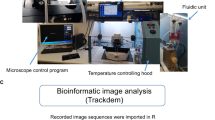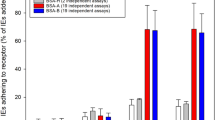Abstract
Sequestration of Plasmodium falciparum-infected erythrocytes in host blood vessels is a key triggering event in the pathogenesis of severe childhood malaria, which is responsible for about one million deaths every year1. Sequestration is mediated by specific interactions between members of the P. falciparum erythrocyte membrane protein 1 (PfEMP1) family and receptors on the endothelial lining2. Severe childhood malaria is associated with expression of specific PfEMP1 subtypes containing domain cassettes (DCs) 8 and 13 (ref. 3), but the endothelial receptor for parasites expressing these proteins was unknown4,5. Here we identify endothelial protein C receptor (EPCR), which mediates the cytoprotective effects of activated protein C6, as the endothelial receptor for DC8 and DC13 PfEMP1. We show that EPCR binding is mediated through the amino-terminal cysteine-rich interdomain region (CIDRα1) of DC8 and group A PfEMP1 subfamilies, and that CIDRα1 interferes with protein C binding to EPCR. This PfEMP1 adhesive property links P. falciparum cytoadhesion to a host receptor involved in anticoagulation and endothelial cytoprotective pathways, and has implications for understanding malaria pathology and the development of new malaria interventions.
This is a preview of subscription content, access via your institution
Access options
Subscribe to this journal
Receive 51 print issues and online access
$199.00 per year
only $3.90 per issue
Buy this article
- Purchase on Springer Link
- Instant access to full article PDF
Prices may be subject to local taxes which are calculated during checkout


Similar content being viewed by others
References
Murray, C. J. et al. Global malaria mortality between 1980 and 2010: a systematic analysis. Lancet 379, 413–431 (2012)
Kraemer, S. M. & Smith, J. D. A family affair: var genes, PfEMP1 binding, and malaria disease. Curr. Opin. Microbiol. 9, 374–380 (2006)
Lavstsen, T. et al. Plasmodium falciparum erythrocyte membrane protein 1 domain cassettes 8 and 13 are associated with severe malaria in children. Proc. Natl Acad. Sci. USA 109, E1791–E1800 (2012)
Avril, M. et al. A restricted subset of var genes mediates adherence of Plasmodium falciparum-infected erythrocytes to brain endothelial cells. Proc. Natl Acad. Sci. USA 109, E1782–E1790 (2012)
Claessens, A. et al. A subset of group A-like var genes encodes the malaria parasite ligands for binding to human brain endothelial cells. Proc. Natl Acad. Sci. USA 109, E1772–E1781 (2012)
Mosnier, L. O., Zlokovic, B. V. & Griffin, J. H. The cytoprotective protein C pathway. Blood 109, 3161–3172 (2007)
Rask, T. S., Hansen, D. A., Theander, T. G., Gorm Pedersen, A. & Lavstsen, T. Plasmodium falciparum erythrocyte membrane protein 1 diversity in seven genomes—divide and conquer. PLOS Comput. Biol. 6, (2010)
Salanti, A. et al. Evidence for the involvement of VAR2CSA in pregnancy-associated malaria. J. Exp. Med. 200, 1197–1203 (2004)
Fukudome, K. & Esmon, C. T. Identification, cloning, and regulation of a novel endothelial cell protein C/activated protein C receptor. J. Biol. Chem. 269, 26486–26491 (1994)
Simmonds, R. E. & Lane, D. A. Structural and functional implications of the intron/exon organization of the human endothelial cell protein C/activated protein C receptor (EPCR) gene: comparison with the structure of CD1/major histocompatibility complex α1 and α2 domains. Blood 94, 632–641 (1999)
Stearns-Kurosawa, D. J., Kurosawa, S., Mollica, J. S., Ferrell, G. L. & Esmon, C. T. The endothelial cell protein C receptor augments protein C activation by the thrombin-thrombomodulin complex. Proc. Natl Acad. Sci. USA 93, 10212–10216 (1996)
Schuepbach, R. A., Feistritzer, C., Fernandez, J. A., Griffin, J. H. & Riewald, M. Protection of vascular barrier integrity by activated protein C in murine models depends on protease-activated receptor-1. Thromb. Haemost. 101, 724–733 (2009)
Gleeson, E. M., O’Donnell, J. S. & Preston, R. J. The endothelial cell protein C receptor: cell surface conductor of cytoprotective coagulation factor signaling. Cell. Mol. Life Sci. 69, 717–726 (2012)
Fukudome, K. et al. The endothelial cell protein C receptor. Cell surface expression and direct ligand binding by the soluble receptor. J. Biol. Chem. 271, 17491–17498 (1996)
Robinson, B. A., Welch, T. L. & Smith, J. D. Widespread functional specialization of Plasmodium falciparum erythrocyte membrane protein 1 family members to bind CD36 analysed across a parasite genome. Mol. Microbiol. 47, 1265–1278 (2003)
Ghumra, A. et al. Induction of strain-transcending antibodies against Group A PfEMP1 surface antigens from virulent malaria parasites. PLoS Pathog. 8, e1002665 (2012)
Ochola, L. B. et al. Specific receptor usage in Plasmodium falciparum cytoadherence is associated with disease outcome. PLoS ONE 6, e14741 (2011)
Sturn, D. H. et al. Expression and function of the endothelial protein C receptor in human neutrophils. Blood 102, 1499–1505 (2003)
Xu, J., Qu, D., Esmon, N. L. & Esmon, C. T. Metalloproteolytic release of endothelial cell protein C receptor. J. Biol. Chem. 275, 6038–6044 (2000)
Pintao, M. C. et al. High levels of protein C are determined by PROCR haplotype 3. J. Thromb. Haemost. 9, 969–976 (2011)
Dennis, J. et al. The endothelial protein C receptor (PROCR) Ser219Gly variant and risk of common thrombotic disorders: a HuGE review and meta-analysis of evidence from observational studies. Blood 119, 2392–2400 (2012)
Rowe, J. A., Claessens, A., Corrigan, R. A. & Arman, M. Adhesion of Plasmodium falciparum-infected erythrocytes to human cells: molecular mechanisms and therapeutic implications. Expert Rev. Mol. Med. 11, e16 (2009)
Cham, G. K. et al. Sequential, ordered acquisition of antibodies to Plasmodium falciparum erythrocyte membrane protein 1 domains. J. Immunol. 183, 3356–3363 (2009)
Cham, G. K. et al. Hierarchical, domain type-specific acquisition of antibodies to Plasmodium falciparum erythrocyte membrane protein 1 in Tanzanian children. Infect. Immun. 78, 4653–4659 (2010)
Kendrick, B. J., Gray, A. G., Pickworth, A. & Watters, M. P. Drotrecogin alfa (activated) in severe falciparum malaria. Anaesthesia 61, 899–902 (2006)
Rankin, L. G. & Austin, D. L. The use of activated protein C in severe Plasmodium falciparum malaria. Anaesth. Intensive Care 35, 428–432 (2007)
Robak, O. et al. The use of drotrecogin alfa in severe falciparum malaria. Anaesth. Intensive Care 38, 751–754 (2010)
Wang, C. W. et al. Evidence for in vitro and in vivo expression of the conserved VAR3 (type 3) Plasmodium falciparum erythrocyte membrane protein 1. Malar. J. 11, 129 (2012)
Stins, M. F., Gilles, F. & Kim, K. S. Selective expression of adhesion molecules on human brain microvascular endothelial cells. J. Neuroimmunol. 76, 81–90 (1997)
Turner, L. et al. Antibodies against PfEMP1, RIFIN, MSP3 and GLURP are acquired during controlled Plasmodium falciparum malaria infections in naive volunteers. PLoS ONE 6, e29025 (2011)
Acknowledgements
We thank A. Salanti for supplying the full-length VAR2CSA protein and S. Lücking Nielsen for technical assistance. The work was supported by the University of Copenhagen Program of Excellence, Lundbeck Foundation, Danish International Development Agency, Augustinus Fonden, Malaria Capacity Development Consortium and The Danish Medical Research Council, as well as the National Institutes of Health (R01 AI47953 and U19 AI089688 to J.D.S.). M.K.H. was funded by a research grant from the Medical Research Council.
Author information
Authors and Affiliations
Contributions
L.T., T.L., J.D.S. and A.J.B. produced recombinant proteins; J.F. performed the cell microarray experiments; S.S.B., C.W.W., J.E.V.P., M.A.N., M.A. and J.S.J. performed the work with malaria parasites; P.M., J.L. and T.G.T. organized clinical work and processed clinical samples; M.K.H. performed the SPR studies; L.T. performed the ELISA studies. The study was conceived and planned by L.T., T.L. and T.G.T. The manuscript was written by T.L., T.G.T., L.T., J.D.S. and M.K.H. All authors read and commented on the manuscript. L.T. and T.L. contributed equally to this work.
Corresponding authors
Ethics declarations
Competing interests
The authors declare no competing financial interests.
Supplementary information
Supplementary Information
This file contains Supplementary Tables 1-4 and Supplementary Figures 1-6. (PDF 3517 kb)
PowerPoint slides
Rights and permissions
About this article
Cite this article
Turner, L., Lavstsen, T., Berger, S. et al. Severe malaria is associated with parasite binding to endothelial protein C receptor. Nature 498, 502–505 (2013). https://doi.org/10.1038/nature12216
Received:
Accepted:
Published:
Issue Date:
DOI: https://doi.org/10.1038/nature12216
This article is cited by
-
Profiles of global mutations in the human intercellular adhesion molecule-1 (ICAM-1) shed light on population-specific malaria susceptibility
BMC Genomics (2023)
-
In vitro model of brain endothelial cell barrier reveals alterations induced by Plasmodium blood stage factors
Parasitology Research (2023)
-
Escaping the enemy’s bullets: an update on how malaria parasites evade host immune response
Parasitology Research (2023)
-
Genetics of cerebral malaria: pathogenesis, biomarkers and emerging therapeutic interventions
Cell & Bioscience (2022)
-
Seroprevalence of SARS-CoV-2 antibodies among children and adolescents recruited in a malariometric survey in north-eastern Tanzania July 2021
BMC Infectious Diseases (2022)
Comments
By submitting a comment you agree to abide by our Terms and Community Guidelines. If you find something abusive or that does not comply with our terms or guidelines please flag it as inappropriate.



